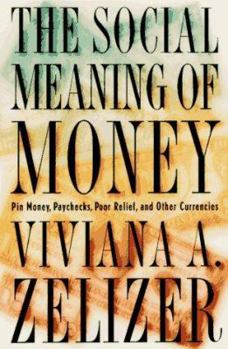The Social Meaning of Money: Pin Money, Paychecks, Poor Relief, and Other Currencies - (Original Edition)
Select Format
Select Condition 
Book Overview
A dollar is a dollar--or so most of us believe. Indeed, it is part of the ideology of our time that money is a single, impersonal instrument that impoverishes social life by reducing social relations... This description may be from another edition of this product.
Format:Paperback
Language:English
ISBN:0691048215
ISBN13:9780691048215
Release Date:August 1997
Publisher:Princeton University Press
Length:304 Pages
Weight:0.85 lbs.
Dimensions:0.6" x 5.5" x 8.5"
Customer Reviews
2 ratings
Money isn't neutral currency - it is earmarked with social meaning.
Published by Thriftbooks.com User , 17 years ago
This book is an academically rich history of the role of money in society - particularly US society since the late 1800s. It begins, somewhat vehemently in establishing its credentials as an alternative way of looking at money. Cash isn't just a neutral medium of exchange; a medium that renders all human effort and interactions in mere dollar terms. Today this argument doesn't need to be made so forcefully, though I wonder if the author had a point to prove. She wrote this over several years in which Friedman economics was at its callous height. Today there is a richer body of work about the psychology of money - for example the studies on 'mental acounting' of Kahneman and the late Amos Tversky. But those authors are theoreticians. What Zelizer demonstrates through a startling degree of social research is that humans being humans, we have an extraordinary facility of earmarking money with specific social meanings. In your home you may well have a petty change dish for the parking meter money, a secret stash of emergency money and a piggy bank for the kids' savings. And because we attach different meanings to these different stashes, we treat them differently also. We operate each stash by different rules. Zelizer shows how household money (once the domain only of the husband - she cites a New York judge who find a woman guilty of theft for "stealing loose change" from her husband's trouser pockets) has changed, and how the rules have slowly though not easily altered also, as society has become more consumerist, and as gender roles have changed also. I found equally fascinating the description of the little white lies that husbands and wives tell, in order to keep a little extra "me money" outside of the household budget. This book totally gels with the findings I've seen in focus groups that I've run where I've found big ticket purchases have been less about the actual cost than about how husbands and wives (or partners) get what they want while trying not to rock the relationship boat. Zelizer's social history is fascinating to read. It is well footnoted (the references are copious): a book that makes pertinent points about the rich social dimension of cash. This is very interesting material and heartily recommend for researchers, for those in the finance sector and for anyone who wants to better understand the financial dynamic of their own relationships. It is a rewarding portrait of our society and the way we attempt to reconcile our rational and emotional selves. Zelizer's follow-up volume is also well worth investigating: The Purchase of Intimacy
A Different Perspective on Money
Published by Thriftbooks.com User , 20 years ago
Viviana Zelizer (VZ) provides an excellent alternative view to what the meaning and social significance of currency is and was in various sub-cultures in the United States. There isn't a day that goes by that I don't identify an application of VZ's analogy between the empty soup cans used by immigrants to the US to compartmentalize savings for different purchases of durable goods to that of our current mental compartmentalization of savings for different purchases. Essentially, people have there own unique utility graphs for different products - whether we realize it or not. VZ illustrates how these differing utility graphs overlap in the sub-cultures of the past, present, and future. I recommend this book for anybody interested in monetary history.






